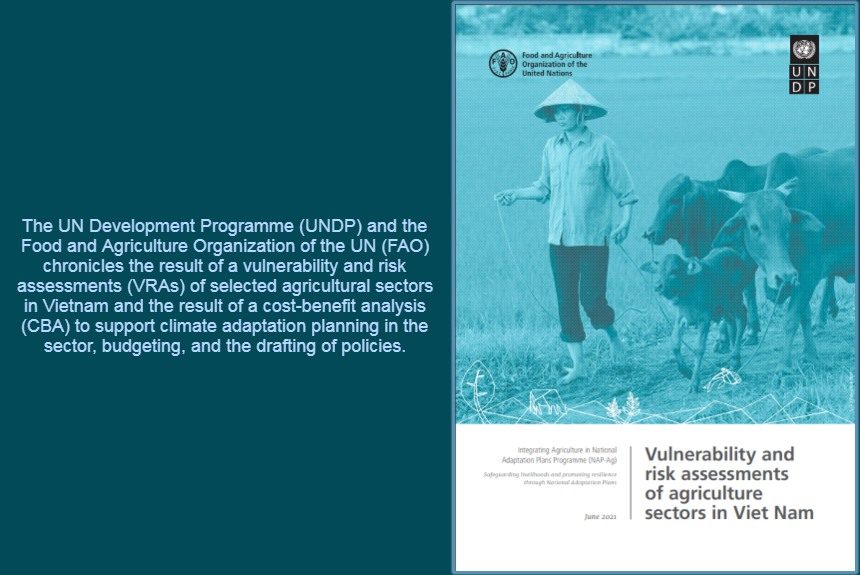Vietnam is among the most vulnerable countries to climate change; its agricultural sectors – crops, livestock, fisheries, and aquaculture-are susceptible to climate change impacts. If nothing is done about it, it will have a knock-on effect on the country’s GDP.
Vietnam has a total land area of 331, 051 square km and an extended coastline of 3400 km. It has two major deltas – the Red River Delta in the North and the Mekong River Delta (MRD) in the South.
The northern part of Vietnam is mountainous and hilly. Changes to its rainfall pattern have been observed with a decreasing rainfall in the North and increasing in the South between 1958 and 2014.
The country experienced a range of natural hazards with damages caused by floods, droughts, landslides, erosion, cyclones, and tropical storms. Climate change is projected to increase the frequency of natural hazards, which can affect its development.
The UN Development Programme (UNDP) and the Food and Agriculture Organization of the UN (FAO) chronicles the result of a vulnerability and risk assessments (VRAs) of selected agricultural sectors in Vietnam and the result of a cost-benefit analysis (CBA) to support climate adaptation planning in the sector, budgeting, and the drafting of policies.
Vietnam’s agricultural sector employs around 35% of its labour force, contributing 15% to its GDP in 2019 and supporting 65% of Vietnamese living in rural areas.
To understand the climate risk to the sector, the Integrating Agriculture in National Adaptation Plans (NAP–Ag) programme provided financial support to the Ministry of Agriculture and Rural Development (MARD) and conducted comprehensive climate change vulnerability and risk assessments (VRAs) at a national level for its crop, livestock, aquaculture, and water resources sectors between December 2016 and December 2018.
The assessments are used to identify and later prioritise climate adaptation actions and develop an evidence-based and risk-informed National Adaptation Plan (NAP) for Vietnam’s agriculture sector.
The VRAs covered 706 districts in 63 provinces for the crops and livestock sectors; 698 districts in 63 provinces for the aquaculture sector; and 714 districts with 53,813 water resources infrastructure consisting of reservoirs, pumping stations, weirs, canals, and sluices.
Some of the highlights of the report include:
- Vulnerability and Risk assessments (VRAs) were conducted for crops, livestock and aquaculture sectors, and the water infrastructure to inform sector-specific measures for Vietnam’s NAP. Vulnerability is assessed based on the following indicators – climate change exposure indicators, climate change sensitivity indicators, and climate change adaption indicators for crops, livestock and aquaculture, ad indicators for water resources infrastructure.
- Based on climatic, socio-economic, and agricultural data, a vulnerability index (VI) was developed for 6 types of crops (rice, maise, sugarcane, coffee, fruits, cassava), 5 livestock (pig, poultry, cattle, buffaloes, dairy), 2 aquaculture varieties (fish, shrimp), and 53,813 water resources infrastructure assets.
- The VIs show that the most vulnerable regions by sector are the Northern Central Coastal Region (NCR) (for crops and aquaculture sectors), the Southeast Region (SER) (for aquaculture), the Mekong River Delta (MRD) (for aquaculture and crops), the Northern West Mountainous Region (NWM) (for crops), and the Red River Delta (RRD) (for livestock).
- For water infrastructure, over 36% of sampled reservoirs were classified as very highly or highly vulnerable to climate change. Almost 57% of pumping stations assessed were classified as very high or high vulnerability.
- Climate adaption was identified for each sector. A cost-benefit analysis (CBA) helps prioritise climate adaptation measures in the crops, aquaculture, and livestock sectors such as rice intensification and integrated cassava and peanut cultivation.
In the water resources sector, the CBA helped prioritise infrastructure assets where climate adaptation measures would improve their resilience to climate change and minimise potential climate change impacts on society.
To read the entire report, click the link below:
Source Citation:
UNDP & FAO. 2021. Vulnerability and risk assessments of agriculture sectors in Viet Nam. Bangkok. Retrieved from UNDP & FAO. 2021. Retrieved from https://www.adaptation-undp.org/sites/default/files/resources/vietnam_country_case_study-nap-ag.pdf



Leave a Reply